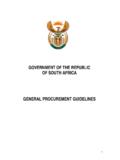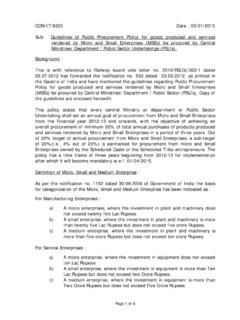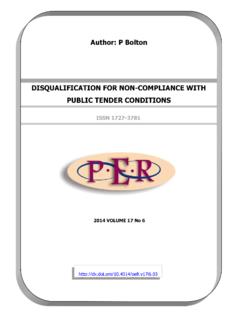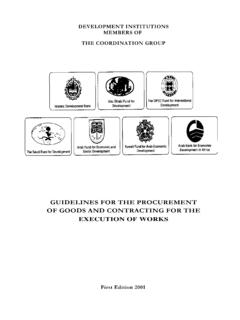Transcription of e-Procurement in Indian Railways - NISG
1 Case Studies on e-Governance in India 2012 - 2013 e-Procurement in Indian Railways Sanjay Aggarwal V. K. Srivastava Case Studies on e-Governance in India 2012 - 2013 e-Procurement in Indian Railways Sanjay Aggarwal V. K. Srivastava Case Studies on e-Governance in India 2012 - 2013 Page | i About the Initiative This publication is a part of the Capacity Building initiative under the National e-Governance Plan (NeGP) by NeGD with an aim to draw out learnings from various projects implemented in various States/ UTs and sharing this knowledge, in the form of case studies, with the decision makers and implementers to benefit them, by way of knowledge creation and skill building, from these experiences during planning and implementation of various projects under NeGP.
2 Conceptualised and overseen by the National e-Governance Division (NeGD) of Media lab Asia/DeitY these case studies are submitted by e-Governance Practitioners from Government and Industry/Research Institutions. The cases submitted by the authors are vetted by experts from outside and within the Government for learning and reference value, relevance to future project implementers, planners and to those involved in e-governance capacity Building programs before they are recommended for publication. National Institute for Smart Government (NISG), working on behalf of this NeGD provided program management support and interacted with the authors and subject matter experts in bringing out these published case studies.
3 It is hoped that these case studies drawn from successful and failed e-Governance projects would help practitioners to understand the real-time issues involved, typical dilemmas faced by e-Governance project implementers, and possible solutions to resolve them. Acknowledgment NISG sincerely thanks all the authors for documenting and sharing their rich experiences in terms of challenges and lessons learned and allowing us to publish and use these case studies in various training programs of NeGD and NISG. NISG also thanks all the external and internal experts who helped review the submitted cases, providing critical observations and for helping in articulating and presenting the case studies, both for class room use as well as a reference article.
4 Copyright License This case study submitted by author/s and accepted for publication under the project of National e-Governance Division (NeGD), Ministry of Communications and Information Technology, Government of India by NISG, the program management agency, is governed by the following license of the Creative Commons. For any specific permission/feedback the publisher may be contacted. (cc) Creative Common License - Attribution-Share Alike Generic Case Studies on e-Governance in India 2012 - 2013 Page | ii The user is therefore free to make derivative works, with credit to the original author.
5 Disclaimer This publication is a work product produced by external authors with information sourced from their own sources as provided under reference in respective articles and is based on experiences with Projects undertaken directly or as research initiatives closely working with the project owners or with their consent to publish the findings. The authors have provided a plagiarism declaration as per project guidelines and National Institute for Smart Governance (NISG) has put in best efforts to validate the authenticity and learning value of the article submitted.
6 NISG has acted mainly as a content reviewer with support from identified expert resources. NISG is not responsible for any plagiarism violations or copyright infringements and respective authors are fully responsible for the same as per respective declarations provided by them. The case study should not be used as a definite source of data. The case studies are meant for use as a background and quick reference on the topic(s) by e-Governance practitioners, and should not be treated as a guideline and/or instructions for undertaking the activities covered under any e-Governance project/s.
7 It may also be used in a classroom for discussion by the participants undergoing e-Governance related training programs. The document by no means has any commercial intention and is solely developed for the purpose of knowledge sharing. NISG-CBKM 71-200/Case Study/10-2014/V2 Printed & Published by National Institute for Smart Government on behalf of the National e-Governance Division (NeGD) Department of Electronics & Information Technology Ministry of Communications & IT Government of India Case Studies on e-Governance in India 2012 - 2013 Page | iii Table of Contents 1.
8 1 2. Key Words/ Key Phrases .. 1 3. Note to Practitioners .. 1 4. Project Context .. 2 5. Benefits .. 10 6. Issues and Challenges 12 7. Lessons Learnt and Take Away .. 15 8. References .. 16 Authors .. 16 Project Fact Sheet .. 17 Case Studies on e-Governance in India 2012 - 2013 Page | 1 1. Abstract After enactment of IT Act 2000, Railways in the year 2001 decided to conduct trial of web based e-Procurement . Trials were started in 2005 in ASP (Application Service Provider) mode on Northern Railways and considered successful as about 5000 tenders were successfully floated during July 05 to Jul 08.
9 Based on this experience, another project was sanctioned in the year 2006 for implementation of e-Procurement system on eight zonal Railways and five production units through Railways own society CRIS. This was sanctioned to improve the transparency in procurement process and also to eliminate various problems of manual tendering. It was also decided that initial investment made by the Railways in IT infrastructure for Materials Management Information System (MMIS) should be protected and e-Procurement system should be dovetailed with this not only for economic considerations but also for better acceptability among Railways personnel who are familiar and used to the existing system.
10 The project of e-Procurement on Indian Railways (handling about 10,000 tenders per month) has been a great success mainly due to thrust on training, education and hand holding the users and successfully handling security concerns of the stake holders to bring confidence in them. It has improved competitiveness and image of the buying organization apart from being of immense use to vendors. As a result of this implementation, the processes have also been standardized and streamlined. The commitment and support of the top management, telephonic and email helpdesk and continuous improvement using stakeholder s feedback/suggestion were the additional factors leading to success of the system.












